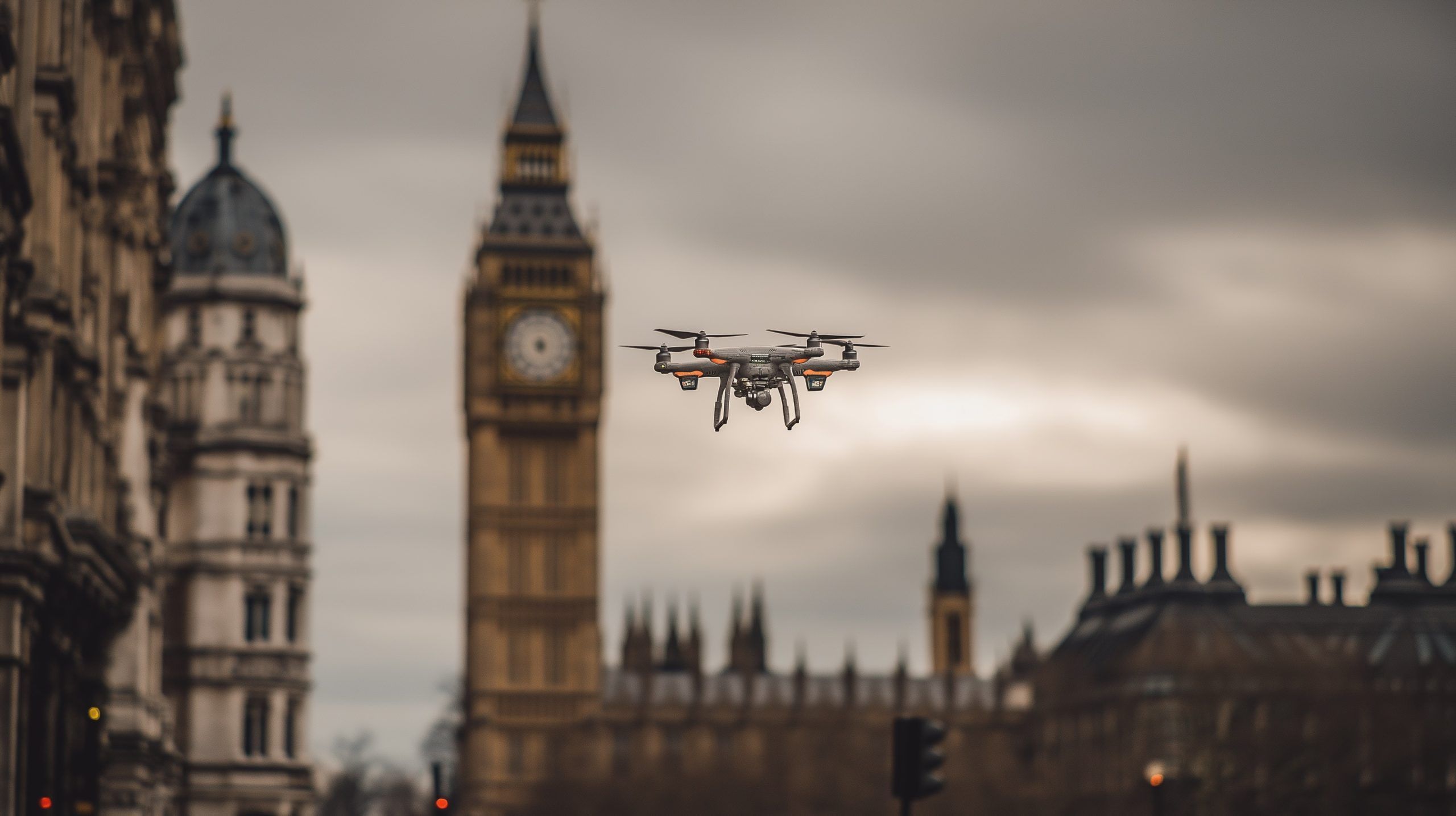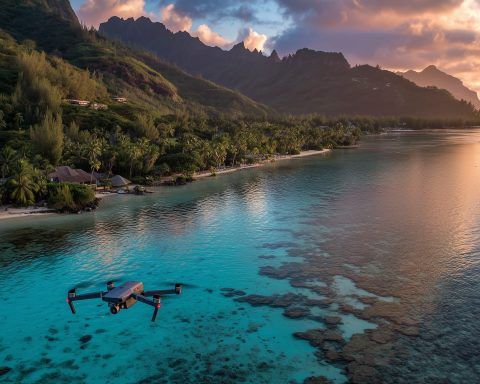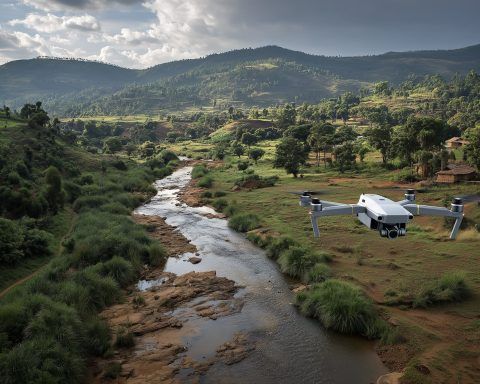- In the UK, drone operations are regulated by the Civil Aviation Authority (CAA) under the Air Navigation Order 2016, with the Drone and Model Aircraft Code acting as the ‘Highway Code’ for pilots.
- Most drones over 250 g or with a camera must be registered, requiring an Operator ID (about £10–£12 for 1 year) and a Flyer ID (free, valid for 5 years).
- The maximum altitude is 120 m (400 ft) above ground level, with an exception allowing a brief flight over a tall structure within 15 m with the structure owner’s permission.
- Operators must keep the drone in visual line of sight at all times, with FPV flying allowed only under specific conditions and usually with a spotter.
- A baseline rule requires at least 50 m horizontal distance from bystanders, and heavier drones in the urban core fall under Category A3 requiring 150 m from any residential, commercial, industrial, or recreational area.
- London contains no‑fly zones including FRZs around Heathrow (roughly 5 km radius) and London City, plus central London Restricted Areas R157 Hyde Park, R158 City, and R159 Isle of Dogs.
- Open category operations are common for simple recreational flights, while heavier drones or riskier tasks require a GVC and an Operational Authorization in the Specific Category.
- Commercial drone flights must have third‑party liability insurance meeting EC Regulation 785/2004; insurance is mandatory for work, while it is optional but advised for recreational use on drones under 20 kg.
- Royal Parks generally ban drone flights without explicit permission, with Richmond Park offering a designated area under strict conditions.
- Penalties for violations include on‑the‑spot fines around £100, registration fines up to £1,000, and serious offenses carrying up to five years in prison, as illustrated by a 2015 Guardian case where a man was fined £1,800 and had his drone confiscated.
Drone operations in the UK are regulated by the Civil Aviation Authority (CAA) under the Air Navigation Order 2016 and related regulations. The CAA’s Drone and Model Aircraft Code serves as the “Highway Code” for drone pilots, detailing how to fly safely and legally [1]. These rules apply nationwide, including in London, but flying in London requires extra caution given the dense urban environment and additional restricted areas. In general, UK drone laws focus on the risk of the operation (drone weight, proximity to people, location) rather than whether the flight is recreational or commercial [2]. All drone users – whether hobbyists or professionals – must ensure they follow the CAA’s rules to avoid fines or even criminal penalties [3]. London, as a busy metropolitan area with sensitive sites and airports, has specific no-fly zones and stricter oversight, making it essential for pilots to be well-informed before taking to the skies.
Recreational Drone Use Laws in the UK (London Focus)
Recreational or hobbyist drone pilots in London must abide by the UK’s national rules for safe flying. Below are the key requirements for flying a drone recreationally:
- Registration (Operator ID & Flyer ID): Most drones must be registered with the CAA before flight. If you are responsible for a drone that weighs above 250 gor has a camera, you must register as an Operator and get an Operator ID [4]. (Drones classed as toys are exempt from registration [5].) The Operator ID is essentially a license number that must be clearly labeled on the drone. You must be 18 or older to register as an operator [6]. Separately, anyone who will fly the drone needs a valid Flyer ID, which requires passing a free online theory test administered by the CAA [7]. (There is no minimum age to fly, but children under 13 must have a parent/guardian help them register and supervise the test [8].) An Operator ID currently costs about £10-£12 and is valid for 1 year, while the Flyer ID is free and valid for 5 years [9]. It’s against the law to fly without the required IDs, and doing so can lead to fines [10].
- Maximum Altitude: Drones may not be flown higher than 120 m (400 ft) above ground level [11] [12]. This height limit helps prevent conflicts with manned aircraft. Note that 120 m is an absolute ceiling in open airspace; in London’s urban terrain, pilots should also be mindful of buildings and avoid flying more than 120 m above the immediate ground or structure they are over. (An exception exists if you must briefly fly over a tall structure above 120 m, but only within 15 m over it and with the structure owner’s permission [13] [14].)
- Line of Sight: You must keep your drone within visual line-of-sight (VLOS) at all times [15]. In practice, this means you (or a spotter assisting you) should always be able to see the drone with your naked eyes (not just through a camera feed) so you can avoid hazards. First-Person View (FPV) flying with goggles is only allowed under specific conditions (e.g. with a spotter present) and is generally not advisable in crowded areas like London unless you have a special permission.
- Distance from People and Property: Always keep a safe distance from people, property, and vehicles not involved in your flight. As a baseline, do not fly directly over people at any time [16] [17]. For most drones, you should maintain at least 50 m horizontal distance from any uninvolved person (bystanders) [18]. Larger drones should be kept even further away. In fact, if you are flying a heavier drone in a busy area, you fall under the ‘A3’ subcategory which requires staying 150 m away from any residential, commercial, industrial or recreational areas [19] [20] – effectively meaning you cannot fly in central urban London with those drones. Only small, light drones under 250 g are allowed to be flown in congested urban areas or over residential zones, and even then you must fly carefully and not over crowds [21] [22]. Tip: If using a lightweight drone like the DJI Mini series (<250 g), you have more flexibility to fly in London because it’s considered lower-risk; these can be flown in populated areas and even closer to people (though never over crowds), which is why they are popular for city flying [23]. Regardless of drone size, always increase your distance in poor weather or if flying at higher speeds to maintain safety [24].
- Crowds and Large Events: It is illegal to fly over crowds or large gatherings of people (sports events, concerts, rallies, busy parks, etc.) [25] [26]. A “crowd” means any group of people who cannot quickly disperse. In a city like London, that includes things like busy tourist areas, demonstrations, or packed streets. You must plan your flight path to avoid flying over or into any assembly of people. Even with a small drone, flying over a crowd is not allowed for safety reasons.
- Airports and No-Fly Zones: Never fly in the vicinity of airports, airfields, or heliports without proper permission. All major airports have a Flight Restriction Zone (FRZ) extending in a radius and along runways (typically about 5 km around, with extended zones off runway ends) where drones are forbidden [27] [28]. In London, this includes Heathrow, London City, Gatwick, Luton, Stansted, and other airfields. Recreational pilots must stay well outside these zones – at least 5 km away from airport perimeters – unless you have explicit Air Traffic Control permission and CAA authorization for a specific flight [29] [30]. Violating an airport FRZ is a serious offense; endangering an aircraft carries up to 5 years in prison [31]. (More details on no-fly zones are in a dedicated section below.)
- Required Permissions: For an average hobby flight (e.g. taking aerial photos in a quiet area), no special permit is needed beyond having your CAA registration. However, certain actions require additional permission even for recreational users. For example, to fly at night or beyond visual line of sight, or to fly a heavier drone close to people, you would need special authorization from the CAA – though these scenarios are generally beyond normal hobby use. In controlled or restricted airspace (common in London), you must obtain permission in advance. For instance, to fly inside an airport’s FRZ or in a designated restricted area, you’ll need to apply weeks ahead through the proper channels (such as a Non-Standard Flight application to NATS for permission in controlled London airspace) [32]. Always check an official airspace map or drone app before flying to see if the area requires prior permission [33]. Additionally, if you plan to take off or land on someone’s private property or a public park, you may need the landowner’s consent – many London parks and boroughs prohibit drone take-offs/landings via local bylaws (more on this below) [34].
- Other Safety Rules: The drone code also reminds pilots of general safety rules: don’t fly under the influence of alcohol or drugs [35]; don’t operate your drone in a negligent way that could endanger people or property [36]; and conduct pre-flight checks (battery, weather, surroundings) to ensure each flight is safe. Always yield right-of-way to manned aircraft – if you see a helicopter or low-flying plane, immediately descend and land. It’s good practice in London to also avoid sensitive areas like schools, hospitals, or moving vehicles even if not “crowds,” to minimize any risk. By following these rules, recreational users can enjoy drone photography and flying while staying within the law [37]. Violations, even by hobbyists, can lead to enforcement actions, so when in doubt, err on the side of caution and consult the Drone Code or CAA resources.
Commercial Drone Use Laws in London
Commercial drone operations – defined as any flight for work, business, or monetary gain (for example, aerial filming for a client, surveying, or professional photography) – are subject to all the same basic flight rules as recreational use plus additional requirements. Notably, as of 2021 the UK regulations no longer draw a hard line between “leisure” and “commercial” in terms of flight permissions; instead, what matters is the category of operation (Open, Specific, or Certified) based on risk [38]. However, in practice commercial work often involves higher risks or expectations, so extra steps are needed to be compliant and insured. Below are the key legal considerations for commercial drone use in London:
- Registration and Licensing: Commercial operators must ensure both the pilot and the company/individual are properly registered with the CAA. A person or business using drones for work needs a valid Operator ID (which, if it’s a company, can be obtained by registering the organization with the CAA) [39] [40]. Each drone must be labeled with the Operator ID just as in recreational use. All remote pilots flying for the company must hold a Flyer ID and any necessary competency certificates. Importantly, there is no separate “commercial drone license” in the UK; instead, operators must adhere to the appropriate category of operation. Many straightforward commercial jobs (e.g. real estate photography with a small drone) can be done under the Open Category rules (no special permission) as long as you follow the same rules as hobbyists. But if the operation entails flying in circumstances that fall outside the Open category limits – for example, using a heavier drone in a built-up area, flying very close to people, or flying at night in downtown London – then you enter the Specific Category and need additional certification and approval [41] [42].
- Pilot Qualifications (A2 CofC and GVC): For many commercial applications, especially in urban areas like London, pilots will need more than just the basic Flyer ID. The UK has a tiered system of drone qualifications:
- The A2 Certificate of Competency (A2 CofC) is a mid-level certification aimed at allowing operations “close to people” with moderate-size drones. Holding an A2 CofC lets you fly drones up to 2 kg in weight in populated areas under certain conditions – for example, with a proper A2 CofC, a pilot can operate a drone like a DJI Mavic 3 (~900 g) up to as close as 50 m from uninvolved people (in A2 subcategory) instead of having to stay 150 m away [43] [44]. It also allows drones between 250 g and 500 g to be flown in the A1 subcategory (over people, though not deliberately over crowds) [45]. Many commercial drone pilots obtain an A2 CofC so they can legally fly in towns and cities with drones in the 500 g–2 kg range. To get this certificate, you must take a training course (usually one day with an exam) from a CAA-recognized provider.
- The General Visual Line of Sight Certificate (GVC) is a more advanced qualification. A GVC, combined with an approved operations manual, is required to obtain an Operational Authorization from the CAA for the Specific Category [46] [47]. In simpler terms, if you need to do something beyond the Open category limits (e.g. flying a heavy drone in central London, flying at night over the city, operating beyond visual line of sight, etc.), you will likely need a GVC. With a GVC and CAA authorization, operators can fly drones up to 25 kg even in built-up areas, subject to the conditions of their authorization [48]. This effectively replaced the old “PfCO” (Permission for Commercial Operations) that existed before 2021 [49] [50]. The GVC involves a more intensive training and examination process (typically including a theory test and a flight test via a CAA-approved training entity).
- CAA Permissions (Operational Authorization): If your operation cannot be conducted under the standard Drone Code rules (Open category), you must apply to the CAA for an Operational Authorization in the Specific Category [51]. This is common for many commercial drone services in London – for instance, if a film production wants to fly a heavy cinema drone over a city street (which is not allowed under normal rules), the operator would need a Specific category authorization spelling out the conditions and safety measures. To obtain this, as noted, one needs a GVC and must submit an operations manual detailing how flights will be conducted safely [52]. The CAA then issues an Operational Authorization (valid for a period, usually 12 months, renewable) that permits those specific operations. Essentially, this is the new form of “commercial license” – a combination of pilot certification + CAA permission for the intended operation. Many drone professionals in London hold an Operational Authorization that allows them to fly in more challenging environments, provided they follow strict safety protocols. If you’re hiring a drone operator in London, you’ll want to ensure they have this authorization for anything beyond basic low-risk flights.
- Insurance Requirements: For commercial drone flights, third-party liability insurance is mandatory by law. The UK requires that if you fly a drone for “any reason other than recreation, sport, or hobby,” you must have insurance coverage that meets at least the requirements of EC Regulation 785/2004 (an aviation insurance standard) [53]. This means any business use – aerial surveying, inspections, filming, etc. – must carry appropriate public liability insurance for drone operations. Many clients will also ask for proof of insurance before allowing drone flights. Insurance is optional for purely recreational flying with drones under 20 kg [54], but it is strongly recommended even for hobbyists. For drones 20 kg or more (which are rare outside very industrial drones), insurance is always required regardless of hobby or commercial use [55]. Commercial operators in London typically carry insurance not only to comply with the law but also because of the higher risks in urban flying (damage or injury could be costly).
- Operational Logistics and Permissions: Besides CAA licensing, commercial drone pilots in London often need to navigate additional permissions:
- Landowner and Local Authority Permission: Taking off or landing on public land (such as a park or pavement) often requires permission from the authority managing that land. London’s Royal Parks, for example, generally ban drone flying without special permission. Some boroughs have local rules against drones in their parks. A commercial film shoot might need to get a permit from the local council or the parks authority. As another example, flying along the River Thames for a film may require consent from the Port of London Authority and coordination with the Metropolitan Police’s Film Unit [56] [57]. Always check the local bylaws or landowner rules for your launch/landing site.
- Coordination with Law Enforcement: If filming in sensitive locations (near government buildings, events, etc.), commercial operators should inform the Metropolitan Police in advance. London has a Metropolitan Police Air Support Unit and dedicated teams who handle drone inquiries; notifying them as part of your planning (and obtaining any necessary permits) can prevent misunderstandings or operational delays.
- Equipment and Safety Protocols: Commercial operators are expected to maintain their equipment well and operate to a high safety standard. This includes doing risk assessments for each job, keeping maintenance logs, and sometimes issuing Notices to Airmen (NOTAMs) if required for large operations. While these may not be “laws,” they are part of abiding by the CAA requirements and ensuring safety in a congested region like London.
In summary, commercial drone laws in London require pilots to go the extra mile in terms of certification, insurance, and planning. The UK has moved to a risk-based model: simple low-risk operations (even if for money) might be possible under basic rules, but as soon as the job gets complex or close to people, the law demands higher qualifications or special permissions [58] [59]. Businesses using drones should ensure they are fully compliant – this means having a registered operator, certified pilots (A2 CofC or GVC as appropriate), CAA operational authorization for advanced flights, and insurance in place [60] [61]. Non-compliance can lead to severe penalties or invalidate insurance, which is especially risky in a major city.
No-Fly Zones and Restricted Airspace in London
London has strict no-fly zones and airspace restrictions that all drone pilots must respect. These are in place to protect sensitive locations and prevent conflicts with manned aircraft in a busy urban airspace. Flying a drone in a prohibited area can result in immediate police intervention and potential prosecution. Below is an overview of key restricted zones in London:
- Airport Flight Restriction Zones (FRZs): As mentioned, all airports have drone exclusion zones. In the London area, Heathrow Airport has one of the largest FRZs, covering roughly a 5 km radius and extended “runway protection zones” at each runway end [62]. London City Airport similarly has a multi-kilometer FRZ in East London, which overlaps with parts of the City/Canary Wharf area [63]. Other airports just outside London – Gatwick, Luton, Stansted, and London Southend – also enforce 5 km FRZs. Heliports such as the London Heliport in Battersea have smaller FRZs (usually a 1 nm radius). It is illegal to fly any drone within an airport or airfield’s FRZ without prior permission from that airport’s air traffic control [64]. This includes even the takeoff or landing of a drone inside the zone. If you have a legitimate need to fly there (e.g. a roof inspection in the zone), you must request permission well in advance – at least 21 days notice is recommended for major airports [65]. The request typically goes through NATS (National Air Traffic Services) via an online portal, and the airport will review your plan [66]. Flying near airports is one of the most sensitive issues in drone law; violating these zones can lead to hefty fines and possibly imprisonment, especially if a drone endangers a landing/taking off aircraft [67]. Always use tools like the NATS Drone Assist app or the Drone Safe map to identify FRZ boundaries before flying [68].
- Central London Restricted Areas (R157, R158, R159): In addition to airport zones, central London has certain permanent Restricted Areas designated by the government where drones (and other aircraft) are forbidden without special authorization. These include:
- R157: Hyde Park – covering the area around Hyde Park and likely intended to protect royal residences (Buckingham Palace is adjacent) and large public gathering spots.
- R158: City of London – covering central City/Westminster areas (this would include the Houses of Parliament, Downing Street, etc., as well as landmarks like Trafalgar Square and the City’s financial district).
- R159: Isle of Dogs – covering the Canary Wharf area with its tall buildings and also near critical infrastructure.
These zones are essentially no-fly zones for all unmanned aircraft, regardless of drone size. Even sub-250 g drones like the DJI Mini are not exempt – you cannot fly in these zones without express permission from the authorities [69]. The restricted areas are often visible in drone airspace maps (usually shown as red zones). They exist for security and safety; for example, authorities don’t want drones around key government buildings, diplomatic sites, or densely packed skyscrapers unless vetted. If someone truly needs to fly in these areas (e.g. a professional filming project), they would have to apply for a Non-Standard Flight (NSF) permission via NATS and likely get clearance from the Metropolitan Police or security services as well [70] [71]. In practice, casual or hobby flying in central London’s restricted zones is off-limits. Many famous landmarks (Buckingham Palace, Parliament, Tower of London, etc.) fall within these restricted zones or within congested area rules, so they are effectively drone no-fly areas. Pilots should plan to keep well outside these zones; for instance, one might fly near Tower Bridge from the east side of the river (outside the City restricted area) but not directly over Tower Bridge itself without permission [72]. Always check a current airspace chart – for London, the EGR160 “Specified Area” (the large blanket covering central London) will show these embedded restricted sectors [73]. Remember, just because the broader “Specified Area” doesn’t apply to drones does not mean the specific R157/158/159 zones can be ignored – those absolutely apply to drones [74] [75].
- Proximity to Sensitive Sites: Beyond the formal restricted areas, drone pilots must avoid flying close to certain sensitive sites:
- Prisons: All prisons and correctional facilities are strict no-drone zones. It’s illegal to fly over or even near a prison due to the risk of contraband drops and security breaches. In the UK, prison authorities and police actively monitor for drones. Many prisons have specific exclusion zones that might not show up on standard maps, so as a rule, stay well away. If a drone is detected near a prison, it will likely result in police response.
- Military Bases and Ranges: Military sites (barracks, training grounds, radar stations) often have restricted airspace. For example, areas around the Ministry of Defence sites or the many barracks in London (like Wellington Barracks near Buckingham Palace) could have rules against drone overflight. Salisbury Plain (outside London) and other training areas have restrictions too, but within London, just be mindful of any military or royal facility.
- Royal Palaces and Government Buildings: The UK has special protections for certain royal palaces (like Buckingham Palace, Windsor Castle) and government buildings (MI5/MI6 headquarters, etc.). While some of these fall under the R158 zone, others outside it (like Windsor) may have their own no-fly rules. The CAA notes that flying may be restricted around sites such as royal palaces and government buildings for security reasons [76]. It’s best to assume you cannot fly over places like Buckingham Palace, the Tower of London, or the Houses of Parliament without permission, even if you somehow are just outside a restricted zone.
- Hospitals and Emergencies: Drones must not interfere with emergency services. If you’re near a hospital (especially one with a helipad, like the Royal London Hospital in Whitechapel), be extremely careful – an air ambulance helicopter could be operating. During any emergency incidents (fires, accidents), drones should stay away entirely so as not to hamper responders [77]. Temporary flight restrictions can be imposed around major emergencies.
- Temporary No-Fly Zones (Temporary Restrictions): London frequently has temporary flight restrictions (TFRs) or Notice to Air Missions (NOTAMs) that ban drones for limited periods. These might occur during large public events, high-profile gatherings, or security operations. Examples include: the New Year’s Eve fireworks over the Thames (typically a drone ban zone for that night), the London Marathon, state events or visits, or political party conferences [78]. Also, big sporting events (like cup finals at Wembley Stadium) often have no-fly NOTAMs. Pilots should always check for active NOTAMs on the day of flight (using the NATS UAS portal or drone apps) [79]. Flying during a temporary restriction is an offense even if the area isn’t normally restricted.
- Bylaws and Local Restrictions: Apart from airspace rules, London has many local regulations that affect drone use, particularly regarding where you can take off and land:
- Royal Parks: Drones are banned in Royal Parks without explicit permission. The Royal Parks (which include Hyde Park, Kensington Gardens, Richmond Park, Greenwich Park, etc.) have bylaws prohibiting aircraft launches. One exception is that Richmond Park has a designated area where hobbyist model aircraft and drones can fly under certain conditions [80] [81]. Even there, strict rules apply (wingspan limits, no flying at certain times, max 100 m altitude in that area, etc.) [82]. Outside that, assume you cannot fly in any Royal Park. If caught, park authorities or police could take action.
- London Boroughs: Many London borough councils have park regulations or public space protection orders that ban or restrict drone take-offs in their parks and playgrounds. For example, The Royal Borough of Greenwich explicitly bans drone flying in Greenwich Park without written permission [83]. Always look for signage at parks; often you’ll see “No model aircraft or drone flying” signs posted [84]. These are enforceable through local law (bylaws), separate from CAA rules. While flying over a park at height might not violate CAA rules if you’re high enough and just transiting, launching or landing in a park usually needs permission.
- Private Property: Flying over private property isn’t explicitly outlawed by aviation law at altitude, but if you hover low or launch/land on private property without permission, you could face civil action (trespass or nuisance) or even be reported for voyeurism if you appear to be spying. Always respect privacy and consider asking permission if you need to fly low over someone’s land.
- Sites of Special Scientific Interest (SSSI): Some parks or conservation areas around London might be SSSI or otherwise protected natural areas (for example, parts of Epping Forest or wetlands). Bylaws or SSSI rules may restrict drone flights if they could disturb wildlife [85]. Check Natural England or local authority info if flying in green belt or nature reserves around the city.
In summary, London’s no-fly zones include airports, designated security-sensitive zones in the city, and various localities where drones are barred by law. Always do your homework on airspace before flying in London. The CAA provides online maps of airspace restrictions [86], and apps like Drone Assist, UAV Forecast, or manufacturers’ geofencing can be helpful (though apps may not list every local bylaw, so use common sense too) [87] [88]. The combination of permanent restrictions (airports, R157/8/9, etc.) and temporary ones means the “fly/no-fly” map of London can be a patchwork. If in doubt, don’t fly until you verify the area is clear. The risk is not just legal trouble – unauthorized flights in London can pose genuine safety threats and prompt emergency responses. London’s Metropolitan Police have units that respond to drone incidents, and many high-profile areas have detection systems in place. It’s simply not worth the risk of flying in a restricted area without permission.
Penalties and Enforcement
The UK takes drone infractions seriously, especially in a congested place like London. A range of penalties can apply if you break drone laws, from fines to imprisonment, depending on the severity. Enforcement is a joint effort between the CAA and the police (with the Metropolitan Police and City of London Police responsible within London). Here are the key points regarding penalties and how the laws are enforced:
- Fines for Registration Violations: Failure to register your drone (getting an Operator ID) or to have a Flyer ID if required is an offense. Drone owners who do not register by the required time can face a fine of up to £1,000 [89]. This hefty fine underlines how important registration is considered. In practice, if caught flying unregistered, you might be given a chance to register, but the authorities have the power to issue fines immediately. It’s inexpensive and easy to register, so there’s little excuse not to do it.
- On-the-Spot Fines and Police Powers: Under the Air Traffic Management and Unmanned Aircraft Act 2021, police have enhanced powers to deal with drone misuse. Officers can demand that a drone pilot land their drone immediately and show proof of registration and permissions [90]. If you refuse to land when instructed or cannot produce your Flyer/Operator ID when asked, you can be issued a fixed penalty notice. Police can give an on-the-spot fine of about £100 for failing to comply with their instructions or minor offenses [91]. They also can stop and search people or vehicles if they suspect a drone is being used in an offense, and they can seize drones or equipment during such a search [92]. In London, you might see police use these powers if, say, someone is flying a drone near an event or a restricted area – they won’t hesitate to confiscate the drone and issue penalties.
- Serious Offenses – Heavy Fines and Prison: More serious breaches of drone laws can lead to prosecution in court:
- Flying a drone in a way that endangers an aircraft (for example, near an airport flight path) is one of the gravest offenses – it carries a maximum sentence of 5 years in prison [93]. Even if no collision occurs, the mere act of endangering could be prosecuted under endangerment laws.
- Flying in prohibited areas (like the central London restricted zones or over a large crowd) or dangerously over people can be prosecuted under the Air Navigation Order. Courts have issued fines in the thousands of pounds for such offenses. For instance, in one early case a drone pilot was fined £1,800 and had his drone confiscated for flying over football stadiums and near Buckingham Palace [94] [95]. Each specific violation (e.g. flying over a congested area, or not keeping line of sight) can incur a separate fine – in that case the pilot faced nine offenses.
- If a drone causes actual harm or damage, the operator could also face other charges (for example, negligence or even bodily harm charges) in addition to aviation offenses. Property damage or injury would escalate the situation significantly.
- Equipment Seizure and Bans: Courts may not only fine offenders but also confiscate their equipment and even ban individuals from flying. In the above case, the person was given a Criminal Behaviour Order preventing him from owning or operating drones in the future [96] [97]. This means repeat or egregious offenders can effectively be grounded by law. So, if someone repeatedly flies illegally in London, they could be legally barred from flying any drone, and if caught doing so, face further prosecution.
- Enforcement Agencies: The CAA is the regulator and can pursue legal action (they often work in conjunction with the CPS – Crown Prosecution Service – for serious cases). The Metropolitan Police (and City of London Police in the financial district) are typically the ones who will respond on the ground to reports of dangerous drone use. They have specialist teams, especially since the Gatwick airport incident in 2018 prompted greater police focus on drones. There have been nationwide operations (like Operation Foreverwing) aimed at educating and enforcing drone rules. Police helicopters are also equipped to track drones and find pilots from the air if needed. If you’re flying in London and not following the rules, don’t be surprised if a police officer (or two) approaches you – either because they spotted it or because someone called it in. London is filled with CCTV cameras and security personnel, so drone flights attract attention quickly.
- Reporting and Community Enforcement: The authorities encourage the public to report illegal drone use. For instance, City of London Police’s website suggests calling 999 if a drone is posing immediate danger (like near an airport or an ongoing emergency) [98]. For non-emergencies, people can report online or via the non-emergency police line [99]. So, if you break the rules, it might not even require a police patrol to notice – a concerned citizen might report you. This community reporting has led to several investigations.
- Multiple Applicable Laws: Aside from aviation-specific rules, other laws can come into play. Using a drone to spy or harass someone could lead to charges under harassment or voyeurism laws. Flying in a manner that causes public disorder could invoke public nuisance laws. In one notable case, a man who flew a drone over streets and public areas in central London was prosecuted under older public safety laws and given multiple fines [100]. Thus, drone pilots can be charged under whatever statutes apply, not just the ANO.
In essence, penalties range from a slap on the wrist (£100 fine) for minor infractions, up to very severe consequences for dangerous behavior. If you fly responsibly and legally, you should never have to worry about this side of the law. But be aware that ignorance is not a defense – “I didn’t know the rules” won’t get you off the hook if you are caught flying unsafely. Given the potential penalties, it’s always best to err on the side of caution and stay well within the law when operating in London’s airspace. The CAA and police have made it clear that they will enforce the rules, especially after high-profile incidents. By following the Drone Code and being mindful of restricted areas, you can avoid any run-ins with law enforcement and enjoy flying without issue.
Special Considerations for Tourists and Visitors
London is a popular destination, and many tourists may want to capture its iconic skyline with a drone. However, foreign visitors are not exempt from UK drone laws – you must follow the same rules as UK residents. In fact, as a tourist or short-term visitor, it can be a bit tricky to navigate the requirements, but here’s what you need to know:
- Registration for Foreign Operators: If you bring a drone into the UK (or buy one on arrival) and intend to fly it outdoors, you will likely need to register with the CAA just as locals do. The UK is no longer part of the EU drone registration system, so an EU-issued operator ID (or any other country’s registration) is not valid in the UK. This means, for example, if you have a European EASA drone registration, you still have to register anew with the UK CAA for flights in Britain. The good news is registration is online and quick – you can do it from anywhere. You’ll need a UK Operator ID (cost ~£10-£12 as noted) which you obtain by creating an account on the CAA’s Drone Registration website and providing some details and payment. The Operator ID must be attached to your drone [101] [102]. Additionally, if your drone requires a Flyer ID (i.e. it’s over 250 g), you as a remote pilot need to take the CAA’s theory test. The test is available online; it’s in English, so ensure you can manage that. There’s no fee for the test. Even children or teenagers visiting must get a Flyer ID if they will fly a sufficiently large drone (with a parent’s help if under 13) [103]. Essentially, the UK makes no distinction for tourists in the registration process – you must have the paperwork in order before flying. If you’re caught flying without UK registration, you could be fined up to £1,000 even as a visitor [104].
- Bringing Drones through Customs: There are generally no restrictions on importing small consumer drones for personal use into the UK. You can bring your drone in your luggage (it’s recommended to carry it in hand luggage and follow airline rules for lithium batteries – usually carry batteries in cabin, not checked baggage). UK airport security is familiar with drones. Just ensure your batteries are within airline limits (most drone batteries are fine) [105] [106]. Also, be aware that flying a drone around airports as soon as you land is illegal – so don’t be tempted to take aerials from the airport parking lot! Wait until you’re well away from any airport and have done your checks.
- Understanding Local Rules: As a visitor, it’s crucial to research local London restrictions (like the no-fly zones we discussed). Many tourists assume they can fly at famous landmarks for fun, only to find that those spots are off-limits. For example, you cannot just fly a drone at the Tower of London or near the London Eye – central London is essentially a no-go without special permission. If you head out of the city to, say, the countryside or coastline, rules may be more relaxed, but always verify. The CAA’s Drone Assist app or similar can be very handy for someone unfamiliar with the area. It will show you if your location is clear to fly or if restrictions apply. When traveling with a drone, always plan ahead: find a safe, legal location before you launch, rather than spontaneously flying in a touristy area (which will likely be illegal due to crowds or restricted airspace).
- Tourist Attractions and Crowds: Remember that tourist-heavy areas are effectively off-limits because of the “no crowds” rule [107] [108]. Even if not a formally banned zone, if you’re surrounded by people (like in front of Buckingham Palace with hundreds of tourists around), you cannot take off there. This often frustrates visitors, but it’s a matter of safety and law. If you absolutely want drone footage of a landmark, consider hiring a UK-licensed drone operator who has the clearances – for example, some companies have permission for restricted areas and can capture those shots legally. Otherwise, look for open areas away from people. Early mornings or less busy spots outside central London might be options, but again, watch for local restrictions.
- Short Visits and Testing: If you’re only in the UK for a very short time, you might wonder if it’s worth going through the registration and test. Realistically, if you want to fly even once, you should do it. The test isn’t hard if you read the Drone Code (and this guide!), and it can be done quickly online. The registration and test can all be completed in a single day if needed, and you get your Flyer ID instantly upon passing. It’s a small investment of time to avoid legal trouble. Keep digital copies of your Operator ID and Flyer ID (or print them) to have on hand in case a police officer asks for them [109].
- Insurance for Tourists: If you’re just doing hobby flying on vacation, insurance is optional (though wise). But note, if your drone use during your visit is in any way commercial (maybe you’re a travel vlogger monetizing footage or on a job), then insurance is mandatory by law [110]. Some travel insurers offer drone liability coverage as an add-on; otherwise, specialist drone insurance companies might offer short-term cover for international users. At a minimum, ensure you could cover costs if your drone accidentally causes damage. Cities like London have lots of property and people – even a small incident could be expensive.
- Language and Communication: If English isn’t your first language, be prepared that all signage, apps, and communication with authorities will be in English. The CAA resources are English-language. It might help to have a translation of key rules in your language, but ultimately the responsibility is on you to follow the English-language laws. If approached by police, it’s important to be cooperative. If you have your documents and explain that you’re a tourist following the rules, they’ll usually be understanding (they may check your IDs and then let you continue if everything is in order and you’re flying safely). However, if you breach rules and claim ignorance due to being foreign, it won’t likely get you off the hook.
- Cultural Sensitivity: Tourists should also consider that flying drones can sometimes be seen as a nuisance or privacy invasion. British culture values privacy; people may react poorly if they see a drone hovering over them at a park or near their apartment window. Always be mindful of privacy (which we cover in the next section). It’s often a good idea to avoid flying in residential areas or where people might feel intruded upon, especially as a visitor. Stick to open areas, and if someone asks you to stop flying over a particular spot (even if it’s legal), it’s often best to politely comply to avoid conflict.
In summary, tourists must play by the same rules: register, follow the Drone Code, stay out of no-fly zones, and respect privacy. The UK does welcome responsible drone use – even the DJI website notes that tourists are allowed to fly under CAA regulations [111] – but the emphasis is on responsible. If you’re only in London for a few days, you might even consider leaving the drone at home unless you have a clear plan for a legal flying location. Many popular tourist cities worldwide have heavy drone restrictions, and London is no exception. By preparing in advance (getting your ID, scouting legal flight areas outside central London, etc.), you can safely enjoy drone photography on your trip without running into legal trouble.
Data Protection and Privacy Laws for Drone Users
Flying a drone isn’t just about aviation law – you also need to consider data protection and privacy. In the UK (including London), there are strong privacy laws and cultural expectations about not intruding on others. Drones often carry cameras, so drone pilots must be mindful of the rules governing photography/filming from the air. Key points to consider:
- Respect People’s Privacy: The Drone Code explicitly instructs pilots to respect other people’s privacy whenever using a drone with a camera or listening device [112]. Practically, this means you should avoid capturing footage of people in situations where they expect privacy. Do not film or photograph people in their home, garden, or any private space without permission. Flying a drone to peek into someone’s window or yard is not only unethical, it’s likely illegal under data protection and surveillance laws [113]. The UK’s Data Protection Act 2018 (which implements GDPR) can apply to personal data collected by drones [114]. If a drone camera captures identifiable individuals, you become a sort of “data controller” of that footage and may have legal obligations if you were to keep or use it.
- Personal vs Commercial Use Distinction: If you’re a hobbyist casually filming scenery and you incidentally catch people in a public space, the ICO (Information Commissioner’s Office) guidance suggests that purely personal or household use of a camera drone might not trigger full data protection requirements [115]. However, the ICO still recommends all drone users follow privacy best practices [116]. The moment you use a drone for any professional or organized purpose (real estate photography, filming for YouTube monetization, etc.), data protection laws fully apply. You would be expected to ensure you have a legal basis for recording people, just as a CCTV operator would. For commercial drone use, you likely need to register with the ICO as a data controller if you record members of the public, and you must meet requirements like handling footage securely and deleting it when not needed [117]. Always err on the side of caution – treat your drone footage with the same care as any other sensitive recording.
- Notify People When Filming: One key piece of advice is to let people know before you start recording or photographing them [118]. Obviously, you can’t individually warn everyone in a city, but the principle is to avoid stealth or secret filming. If you’re flying in a relatively close area and there are bystanders nearby, you might let them know, “Hey, I’m going to do some aerial photography of the landscape, I won’t be focusing on you.” This transparency can put people at ease. In some cases (especially commercial shoots), putting up signs that “Drone filming in progress” is a good practice. It gives people a chance to avoid the area or voice concerns. Remember that Londoners are quite used to CCTV being around, but a drone can feel more intrusive since it’s not fixed and can potentially look into spaces that a street camera cannot.
- Avoid Sensitive Data Capture: Be aware of what your camera can do and what kind of images it can take [119]. High-resolution drones can zoom or see things from far away – for example, through office windows or into backyards. You should avoid using these capabilities in a way that gathers sensitive information. It could be illegal to use a drone to eavesdrop on conversations or capture someone’s PIN number as they enter it, for instance. The law specifically prohibits using drones for criminal or terrorist surveillance purposes [120]. Common sense: don’t be a snoop. If you inadvertently capture something private (say, people in their yard), it’s best to delete that footage and certainly not share it.
- General Data Protection Regulation (GDPR): The UK still follows GDPR principles. Any photo or video of an identifiable person is personal data. If challenged, you should have a justification for why you recorded it. For a hobbyist, “I was just taking a landscape shot and people happened to be in it” is usually okay, as long as you’re not using it in a harmful way. But if you were, for example, hovering over a private garden, that could be a GDPR breach. If someone feels their privacy was invaded by your drone, they can complain to the ICO. The ICO has issued guidance to drone users that essentially aligns with Drone Code: limit recording of individuals, and if you do record, handle that data carefully [121] [122].
- Wear Visible ID and Be Accountable: The Drone Code suggests making sure you can be clearly seen when you’re out flying [123]. This is actually a privacy-related point – if people notice a drone, they often want to know who’s operating it. If you stand out in the open (not hiding in a car or behind a tree), it lets observers know the drone is under responsible control and who to approach if they have concerns. Some commercial operators even wear hi-vis vests with “Drone Pilot” on them when working – this is not required, but it demonstrates transparency. For the average person, just don’t be sneaky. Flying covertly raises suspicions.
- Think Before Sharing Footage: In today’s social media age, you might capture something interesting and want to post it. Always think carefully before sharing photos or videos from your drone [124]. If the footage clearly identifies people (faces, car license plates, etc.), consider blurring those or obtaining consent if it’s a close-up. Do not share anything that could be unfair or harmful to someone’s privacy. For example, if your drone caught someone in an embarrassing situation on their balcony, uploading that would likely violate their privacy and could even lead to legal action against you. Apply the same standards as you would for any camera – just because it’s from the air doesn’t make it magically okay.
- Secure Your Data: Treat your drone footage securely. The Drone Code advises to keep photos and videos secure and delete anything you don’t need [125]. This is both for privacy and your own liability – if you don’t need the footage, don’t hoard it, especially if it has people in it. If your storage or card gets lost or hacked, unneeded sensitive footage could get out. Commercial operators should have data management policies to comply with data protection law (e.g., encrypting stored footage of individuals, etc.).
- ICO and Surveillance Camera Code: The UK has a Surveillance Camera Code of Practice (applicable more to public bodies, but its principles can guide private drone users too). The ICO’s website has a drones guidance section [126] that essentially echoes what we’ve discussed: limit recording, inform people, use footage responsibly. If you’re operating a drone in a public space and especially if using advanced tech like facial recognition or long zoom lenses, know that you are bordering on regulated surveillance territory [127] [128]. For example, any use of automated tracking or face recognition via drone would be highly scrutinized under law.
In London, privacy is a big concern – it’s a crowded city but people still expect some degree of anonymity in the crowd. A drone buzzing around with a camera can make people uneasy. To be a respectful pilot: don’t hover over people, don’t record them up close without consent, and follow the golden rule of “how would I feel if someone recorded me or my family in this manner?”. By following the Drone Code’s privacy points [129] [130] and the law (Data Protection Act 2018), you’ll avoid most privacy pitfalls. And remember, aside from legal factors, maintaining good community relations is important – if drone users get a reputation for being pests or spies, it can lead to public backlash and stricter laws. So always be a considerate ambassador for the hobby or industry by respecting privacy.
Upcoming Changes and Proposals in Drone Legislation
Drone regulations continue to evolve. The UK government and CAA regularly review the rules to keep up with technology and safety needs. As of 2025, there are some significant changes on the horizon that drone users (in London and across the UK) should be aware of. Here are the key upcoming changes and proposals in drone legislation:
- Introduction of Drone Remote ID (2026): The CAA has confirmed plans to implement “Direct Remote ID” requirements for drones by January 1, 2026 [131]. Remote ID will require drones to broadcast identification and location information in real-time, much like an “electronic license plate.” This change is aimed at security and accountability – authorities will be able to identify drones and their operators from the ground. If you’re buying new drones in the coming years, expect that models will start including Remote ID capability to comply with the future law. For existing drones, there may be add-on modules or other transitional provisions. The CAA’s recommendation to the government is to mandate Remote ID for most drones, and this is likely to be enacted in law, aligning somewhat with what the EU and US are also doing [132]. By 2026, if you want to fly in London, your drone might legally need to emit a Remote ID signal that could be picked up by police or air traffic systems.
- Drone Product Standards & Class Markings: The UK is moving toward recognizing official class-marked drones, similar to the EU’s system of C0, C1, C2… classes but with UK-specific labels. The Department for Transport (DfT) and CAA have announced that from 2026, drones will be required to meet certain product standards and carry a class marking that indicates what category of operations they’re built for [133] [134]. For example, a “UK Class C1” drone might be one that’s under 900 g, has certain safety features, and can be flown in the A1/A2 subcategory. Previously, the UK was in a transitional phase after Brexit, not fully adopting EU class labels. But now the proposal is to implement UK-specific markings (possibly mirroring the EU ones but with a UK designation) starting in 2026 [135]. For pilots, this means in the future when you buy a drone, its class will dictate how you can fly it. There’s also a proposal to replace the current exemption for “toys” (drones without cameras) with a simple weight threshold – likely 100 g. In other words, any drone over 100 g would need at least some level of training/registration, removing ambiguity about what is a toy [136].
- Extended Education Requirements: One of the changes coming is an expansion of the mandatory Flyer ID test to more users. Currently, if you fly only very small drones (<250 g) with a camera, you technically didn’t need a Flyer ID (though it was recommended). The CAA has proposed that in the near future, anyone flying a drone over 100 g will need to take the basic online training and test [137]. This is to ensure even hobbyists with tiny drones (like some who thought the 249 g drone excused them from any test) have some knowledge of the rules. So the “No test needed for sub-250 g” rule is going away. Visitors and occasional users would also be caught by this – effectively most drone pilots will have to engage with the Drone Code and pass the quiz, which is a good thing for overall safety. The CAA also mentioned making the guidance more user-friendly and clearer, such as renaming the categories for clarity (they plan to label subcategories A1/A2/A3 as “Fly Over People (A1), Near People (A2), Far from People (A3)” instead of the more abstract labels) [138]. This is meant to help people understand the intent of each category more easily.
- Transitional Period and Legacy Drones: The UK has been in a transitional period allowing “legacy” drones (without class marking) to be used under certain conditions. This transition was set to end at the start of 2026. However, as of May 2025, the CAA signaled it might extend the transition period beyond Jan 2026 [139]. This means you won’t suddenly be grounded in 2026 if your drone doesn’t have a class marking. The goal is to give manufacturers and pilots more time. We await final confirmation, but it’s a sign the CAA is trying to implement changes gradually.
- No Distinction between Commercial and Recreational – Continued: It’s worth noting that the removal of the commercial vs hobby distinction (from 2021) is now an established principle [140]. We expect future legislation to continue on this path – rules based on risk, not purpose. So upcoming changes are not about re-imposing a separate “commercial license,” but rather about making the system easier to follow for everyone. For instance, when class markings come, a hobbyist and a professional with the same drone class will follow the same basic rules for that drone. The difference will be if the professional wants to do something riskier, they’ll use the Specific category route, which remains available.
- Increased Police Powers and Enforcement Tools: In recent years, proposals have been made to give police more technology to handle rogue drones (like drone jammers, etc.). The laws for police powers were updated in 2021 (as discussed in penalties), so no immediate new law is needed there. However, expect that enforcement will incorporate new tech: e.g. Remote ID receivers to track drones in city airspace, drone detection systems at major events, and so on. London, in preparation for events or just day-to-day security, will likely see more deployment of these systems. While not a “law” change per se, it means pilots are more likely to get caught if they break the rules – the net is tightening with technology. Also, the CAA has been working on an Unmanned Traffic Management (UTM) framework and electronic conspicuity for drones, which will evolve alongside Remote ID.
- Future Drone Highways and Urban Air Mobility: Looking further ahead, the UK is exploring concepts like drone corridors for deliveries and even passenger drones (air taxis). London could be a venue for trials in the coming decade. Specific legislation for these (the Certified Category of drone operations) is still in development [141]. As of now, the Certified Category (for the highest-risk operations like large autonomous drones) doesn’t have detailed published rules – they’ll likely adapt manned aviation standards in the interim [142]. For the average user, this is not directly relevant yet. But what it means is regulators are anticipating a more drone-active environment in the future, and they’ll adjust laws to segregate hobby flights from commercial delivery drone flights, etc. So we might see in a few years certain airspace in London dedicated to “drone highways” at certain altitudes, with hobbyists required to stay below those altitudes. No concrete rules on that are in place yet, but proposals and trials (like the Skyway project in some UK cities) are ongoing.
- Miscellaneous Proposed Tweaks: The CAA’s recent consultation (completed in 2023 with decisions announced in 2025) recommended a package of updates:
- Simplifying some rules wording,
- Removing ambiguity about “toy” drones by using a weight cutoff (100 g) [143],
- Possibly adjusting the definitions in the law for “crowds” or residential areas to ensure clarity.
- They also want to improve online resources and education, so pilots better understand rules without digging through legal texts [144].
- Another change is that class-marked drones (when they come) will open up new possibilities: e.g. a true C1-class drone can be flown over people (not crowds) under A1, which is not currently allowed for any legacy drone over 250 g. So once class drones are recognized, if you buy a drone with a UK C1 marking, you’ll have more freedom. Conversely, after the transition, if your drone isn’t class-marked, you might be restricted to A3 (far from people) regardless of weight, which would limit usage in cities. So be aware of that shift coming after 2026 – it may incentivize upgrading to class-marked models for urban flyers.
- London-Specific Proposals: Is there anything unique to London’s drone laws expected? Generally, drone laws are national. However, local authorities in London continuously review their policies too. For example, if there were issues with drone noise or privacy in a certain borough, the council might introduce new local bylaws. One thing to watch is how Royal Parks or other landmark owners adapt – they might create official application processes for drone use (some already did for commercial permits). Also, as drone shows (swarm light shows) become popular, London might accommodate those via special permissions. In short, while no London-only drone legislation is currently proposed in Parliament, the enforcement environment in London will likely get even stricter in step with national changes (with more tech and perhaps more exclusion zones for events).
In conclusion, drone pilots should stay updated over the next couple of years. The rules you passed your test on are being tweaked, albeit not drastically for everyday flying. Key takeaways: by 2026 you’ll likely need Remote ID on your drone, you’ll definitely need to have done the test even for small drones, and new drones will come with class labels that determine how you can fly them [145] [146]. The CAA has stated that for most hobbyist users, the current Drone Code rules on how and where you can fly aren’t substantially changing [147] – so 400 ft limit, keep distances, etc., all that stays. The changes are more about behind-the-scenes improvements (identification, training, manufacturing standards) to support a growing drone ecosystem safely [148] [149]. Always refer to the CAA’s official updates or trusted sources like their SkyWise alerts for the latest. Being in compliance not only keeps you on the right side of the law but also contributes to the overall safe integration of drones in UK airspace as we move into the future.
Sources:
- UK Civil Aviation Authority – Drone and Model Aircraft Code (March 2024) [150] [151] [152]
- UK Civil Aviation Authority – Registering to fly drones and model aircraft (Overview) [153] [154]
- City of London Police – Drones: Your Responsibility and The Law [155] [156] [157]
- UK Civil Aviation Authority – Flying drones for work (CAA Guidance) [158] [159]
- DroneSiteSurveys – UK Drone Laws 2025 & Law Classifications [160] [161]
- Heliguy – UK Drone Laws 2025: Where can I fly? [162] [163]
- Launch Imagery Blog – Flying a Drone in Central London (2023/2025 Guide) [164] [165]
- UK Civil Aviation Authority – Updated rules confirmed to support safe growth of drone sector (News release, May 2025) [166] [167]
- Cedrec News – UK scheme makes drone registration compulsory (2019) [168]
- Farmers Weekly – New drone rules (2019 Gatwick aftermath) [169] [170]
- The Guardian – Man fined for flying drone at football matches and Buckingham Palace (2015 case) [171] [172]
- UK Civil Aviation Authority – Protecting people’s privacy (Drone Code section) [173] [174]
- Information Commissioner’s Office – Drone guidance remarks [175] [176]
References
1. www.cityoflondon.police.uk, 2. www.heliguy.com, 3. register-drones.caa.co.uk, 4. www.cityoflondon.police.uk, 5. www.cityoflondon.police.uk, 6. register-drones.caa.co.uk, 7. www.cityoflondon.police.uk, 8. register-drones.caa.co.uk, 9. register-drones.caa.co.uk, 10. register-drones.caa.co.uk, 11. www.cityoflondon.police.uk, 12. www.heliguy.com, 13. www.heliguy.com, 14. www.heliguy.com, 15. www.cityoflondon.police.uk, 16. register-drones.caa.co.uk, 17. register-drones.caa.co.uk, 18. www.cityoflondon.police.uk, 19. register-drones.caa.co.uk, 20. www.cityoflondon.police.uk, 21. register-drones.caa.co.uk, 22. www.launchimagery.co.uk, 23. www.launchimagery.co.uk, 24. register-drones.caa.co.uk, 25. register-drones.caa.co.uk, 26. register-drones.caa.co.uk, 27. www.fwi.co.uk, 28. www.fwi.co.uk, 29. viddadrones.com, 30. www.launchimagery.co.uk, 31. register-drones.caa.co.uk, 32. www.launchimagery.co.uk, 33. register-drones.caa.co.uk, 34. register-drones.caa.co.uk, 35. www.cityoflondon.police.uk, 36. www.cityoflondon.police.uk, 37. register-drones.caa.co.uk, 38. www.heliguy.com, 39. www.caa.co.uk, 40. www.caa.co.uk, 41. www.heliguy.com, 42. www.heliguy.com, 43. www.launchimagery.co.uk, 44. dronesitesurveys.co.uk, 45. www.heliguy.com, 46. dronesitesurveys.co.uk, 47. dronesitesurveys.co.uk, 48. dronesitesurveys.co.uk, 49. www.caa.co.uk, 50. dronesitesurveys.co.uk, 51. www.caa.co.uk, 52. dronesitesurveys.co.uk, 53. www.cityoflondon.police.uk, 54. register-drones.caa.co.uk, 55. register-drones.caa.co.uk, 56. www.launchimagery.co.uk, 57. www.launchimagery.co.uk, 58. dronesitesurveys.co.uk, 59. dronesitesurveys.co.uk, 60. www.caa.co.uk, 61. www.caa.co.uk, 62. www.launchimagery.co.uk, 63. www.launchimagery.co.uk, 64. register-drones.caa.co.uk, 65. www.launchimagery.co.uk, 66. www.launchimagery.co.uk, 67. register-drones.caa.co.uk, 68. register-drones.caa.co.uk, 69. help.uavhub.com, 70. help.uavhub.com, 71. help.uavhub.com, 72. www.launchimagery.co.uk, 73. www.launchimagery.co.uk, 74. help.uavhub.com, 75. help.uavhub.com, 76. register-drones.caa.co.uk, 77. register-drones.caa.co.uk, 78. register-drones.caa.co.uk, 79. register-drones.caa.co.uk, 80. www.launchimagery.co.uk, 81. www.launchimagery.co.uk, 82. www.launchimagery.co.uk, 83. www.launchimagery.co.uk, 84. register-drones.caa.co.uk, 85. register-drones.caa.co.uk, 86. register-drones.caa.co.uk, 87. register-drones.caa.co.uk, 88. register-drones.caa.co.uk, 89. cedrec.com, 90. www.cityoflondon.police.uk, 91. www.fwi.co.uk, 92. www.cityoflondon.police.uk, 93. register-drones.caa.co.uk, 94. www.theguardian.com, 95. www.theguardian.com, 96. www.theguardian.com, 97. www.theguardian.com, 98. www.cityoflondon.police.uk, 99. www.cityoflondon.police.uk, 100. www.theguardian.com, 101. register-drones.caa.co.uk, 102. register-drones.caa.co.uk, 103. register-drones.caa.co.uk, 104. cedrec.com, 105. www.dji.com, 106. www.dji.com, 107. register-drones.caa.co.uk, 108. register-drones.caa.co.uk, 109. www.cityoflondon.police.uk, 110. www.cityoflondon.police.uk, 111. www.dji.com, 112. register-drones.caa.co.uk, 113. register-drones.caa.co.uk, 114. register-drones.caa.co.uk, 115. www.theguardian.com, 116. www.theguardian.com, 117. register-drones.caa.co.uk, 118. register-drones.caa.co.uk, 119. register-drones.caa.co.uk, 120. register-drones.caa.co.uk, 121. www.theguardian.com, 122. www.theguardian.com, 123. register-drones.caa.co.uk, 124. register-drones.caa.co.uk, 125. register-drones.caa.co.uk, 126. register-drones.caa.co.uk, 127. www.theguardian.com, 128. www.theguardian.com, 129. register-drones.caa.co.uk, 130. register-drones.caa.co.uk, 131. www.caa.co.uk, 132. www.caa.co.uk, 133. www.caa.co.uk, 134. www.caa.co.uk, 135. www.heliguy.com, 136. www.caa.co.uk, 137. www.caa.co.uk, 138. www.caa.co.uk, 139. www.heliguy.com, 140. www.heliguy.com, 141. www.heliguy.com, 142. www.heliguy.com, 143. www.caa.co.uk, 144. www.caa.co.uk, 145. www.caa.co.uk, 146. www.caa.co.uk, 147. www.caa.co.uk, 148. www.caa.co.uk, 149. www.caa.co.uk, 150. register-drones.caa.co.uk, 151. register-drones.caa.co.uk, 152. register-drones.caa.co.uk, 153. register-drones.caa.co.uk, 154. register-drones.caa.co.uk, 155. www.cityoflondon.police.uk, 156. www.cityoflondon.police.uk, 157. www.cityoflondon.police.uk, 158. www.caa.co.uk, 159. www.caa.co.uk, 160. dronesitesurveys.co.uk, 161. dronesitesurveys.co.uk, 162. www.heliguy.com, 163. www.heliguy.com, 164. www.launchimagery.co.uk, 165. www.launchimagery.co.uk, 166. www.caa.co.uk, 167. www.caa.co.uk, 168. cedrec.com, 169. www.fwi.co.uk, 170. www.fwi.co.uk, 171. www.theguardian.com, 172. www.theguardian.com, 173. register-drones.caa.co.uk, 174. register-drones.caa.co.uk, 175. www.theguardian.com, 176. www.theguardian.com










